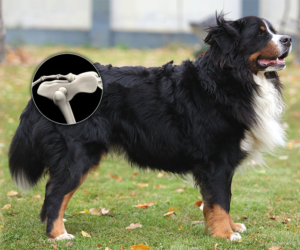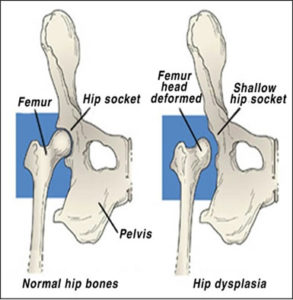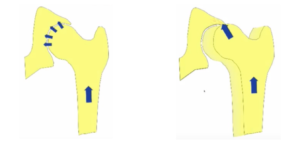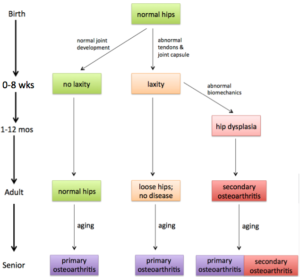Canine hip dysplasia (CHD) is a degenerative hip disease that tends to develop in large breed dogs, such as the Bernese Mountain Dog, affectionately referred to as Berners. CHD significantly decreases the quality of life of a dog and often leads to complete immobility if left untreated. Experts estimate that about 28% of Berners are affected by dysplastic hips, making them the 8th most susceptible dog breed.
At birth, puppy skeletal structures are largely composed of cartilage that is much softer than bone. This softer cartilage is able to adapt much more easily to the rapid growth that occurs during the early months of a dog’s life. In their first few months, Berners will typically gain 2-4 pounds per week, which adds increasingly large stresses to their developing bones and joints. While genetics play a large role in the susceptibility of a dog to develop CHD, the loading cycles and forces on the cartilage greatly shape the development of the dog’s hip.
The hip is a ball and socket joint, where the head of the femur, the very top of the dog’s leg, should fit perfectly into a socket in the pelvis. If the ligaments that hold the femur in the hip socket are too weak or damaged at all, the positioning of the
hip joint will be off and the hip will be subjected to unbalanced forces and stresses over the course of the dog’s life. The distribution of forces experienced by the hip joint in normal hips is evenly spread, while dysplastic hips are subjected to a stress concentration on the tip of the femur. These unnatural forces will cause laxity in the hip joint, leading to instability, pain, and often times the development of osteoarthritis.
There are also a number of environmental factors, many of which are inherent to large dog breeds, that dramatically increase a dog’s susceptibility to CHD. A study by Dr. Wayne Riser concluded that factors such as oversized head and feet, stocky body type with thick, loose skin, early rapid growth, poor gait coordination, and tendency of indulgent appetite all contributed to the development of CHD. All of these features are generally inherent to large breed dogs, such as Berners, so great care must be taken in order to mitigate their effects on the quality of life for these dogs.
Multiple studies have shown that treatment that is implemented early in the dog’s life is much more effective than late-in-life treatments. CHD warning signs can be seen in puppies as young as 4 months old, and most veterinary professionals agree that if scans occur at 2 years of age, the most optimal time for treatment has passed. Since larger stresses will be put on the hip joint as the dog grows, surgical repairs, or changes in diet and exercise, are most effective if implemented before the dog’s skeletal frame is completely developed.
Additional information regarding this topic can be found at The US National Library of Medicine or The Journal of Veterinary Pathology.




